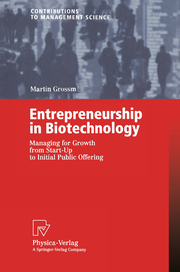Detailansicht
Entrepreneurship in Biotechnology
Managing for Growth from Start-Up to Initial Public Offering, Contributions to Management Science
ISBN/EAN: 9783790800333
Umbreit-Nr.: 1475156
Sprache:
Englisch
Umfang: XVI, 323 S.
Format in cm:
Einband:
kartoniertes Buch
Erschienen am 11.03.2003
- Zusatztext
- Research and development of novel medicines for human therapy commonly takes over a decade before significant revenues from sales are forthcoming. How can biotechnology companies be founded and grow successfully in an industry with such extended innovation processes? The book investigates this problem and distinguishes three growth phases: From incorporation and start-up through collaborative R&D with large pharmaceutical firms to value creation from R&D pipelines to Public Offerings and product marketing. In this book a dynamic simulation model for testing different decision-making strategies is developed. For each phase the author identifies decision rules that provide for successful corporate growth.
- Kurztext
- Research and development of novel medicines for human therapy commonly takes over a decade before significant revenues from sales are forthcoming. This book investigates this problem. It aims to develop a dynamic simulation model for testing different decision-making strategies.
- Autorenportrait
- Inhaltsangabe1 Independent Biopharmaceutical Companies and Their Specialization in Drug Discovery Technologies.- 1.1 Drug Discovery in Research and Development Pipelines.- 1.2 Growth Problems Generated by R&D Duration.- 1.3 Consequences of Human Genetic Research on Drug Discovery.- 2 Model Structure for High-Technology Firms and Its Dynamic Behavior in Start-Up Phases.- 2. 1 Macro Structure for Entrepreneurial Management of Start-Ups.- 2.1.1 System Dynamics as Research Methodology.- 2.1.2 Advancement of a Novel Disease Target Technology as Phase Objective.- 2.1.3 Impacts of Entrepreneurial Confidence on Voluntary Leaving, Absorptive Capacity, and Corporate Planning Horizon.- 2.2 Micro Structure that Determines High-Technology Performance.- 2.2.1 Average Research Experience of Scientists.- 2.2.2 Diversity of Scientific Disciplines.- 2.2.3 Research Quality as Dependent on Understanding of Failures.- 2.3 Dynamic Behavior from Start-Up Model Experiments.- 2.3.1 Surprise Behavior of Technology Effectiveness.- 2.3.2 Start-Up Success as Determined by Conditions of Corporate Foundation.- 2.3.3 Policy Design to Accelerate Start-Up Success.- 3 Model Structure and Dynamic Behavior for High-Technology Firms in Transition to Growth Phases.- 3. 1 Macro Structure for Contract Research.- 3.1.1 Scope of Transition Model, Boundaries, and Time Horizon.- 3.1.2 Feedback Structures for Growth and Growth Saturation.- 3.1.3 Principal-Agent Theory to Investigate Research Contracts.- 3.2 Micro Structure for Contract Research on Novel Disease Targets.- 3.2.1 Industry Demand for Research Contracts.- 3.2.2 Planning of Scientific Laboratory Personnel.- 3.2.3 Obsolescence/Irrelevance of Scientific Experience and Contract Research Funding.- 3.3 Dynamic Behavior from Transition Model Experiments.- 3.3.1 Simulation Studies on Corporate Transition.- 3.3.2 Attractive ness Fluctuations from Technology Effectiveness.- 3.3.3 Firm Value from Contract Research Funds.- 4 Economic Value Creation in Transition Phases: Access to Equity Capital.- 4. 1 Value Creation from Drug Candidates in Collaborative R&D Pipelines.- 4.1.1 Flow of Drug Candidates Through Pipeline Phases.- 4.1.2 Present Value of Royalty Expectations from Drug Candidates.- 4.1.3 Capital Asset Pricing Model for Discount Rate Estimation.- 4.2 Simulation of Value Creation.- 4.2.1 Present Values of Pipeline Phases.- 4.2.2 Option Premium as a Complement to Present Value.- 4.2.3 Option Premium and Present Value for Investment Decisions.- 4.3 Equity Financing for Growth Phases.- 4.3.1 Fund-Raising Success as Determine by Value Creation in R&D.- 4.3.2 Attractiveness to Investors from Research Track Record and Collaborative Partnership.- 4.3.3 Sensitivity of Fund-Raising Success to Value Creation in R&D.- 5 Strategies for Growth Phases to Sustain Independence.- Appendix 1: Parameter List for Start-Up Model.- Appendix 2: List of Equations for Start-Up Model.- Appendix 3: Parameter List for Transition Model.- Appendix 4: A Dynamic Theory on Cost of Capital for Biotechnology Firms.
